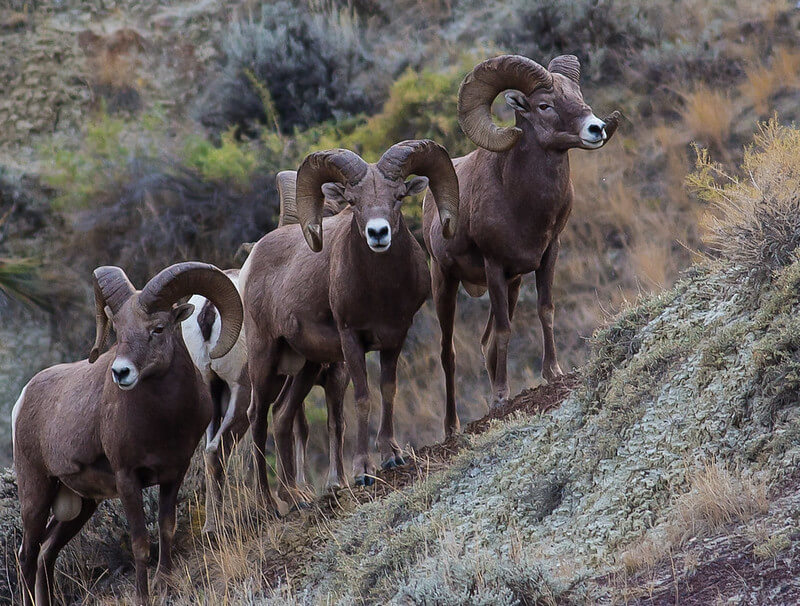How To Eat Lunch, Not Be Lunch: Safety In Numbers
by Erin Sexton
Broadcast 2.25 and 2.28.2020

Photo by Bob Wick, CC 2.0.
Listen:
Now that winter is close upon us and I’m remembering warmer days, one in particular stands out. It is late summer and the sky and landscape are shrouded in an afternoon haze of low lying clouds. I am seated motionless amongst the dried yellow grasses, peering at the wild horses of Wild Horse Island as they graze on patches of green vegetation. This afternoon, the mustang geldings are grazing at the nexus of the trails of the meadow. Suddenly, the tranquil valley is transformed into chaos as, one by one, thirty-seven bighorn ewes and lambs emerge into the meadow, their hooves drumming along the compacted earth of the trail. The herd stays only briefly in the center of the meadow, then moves quickly across to browse at the far edge. Then the sheep slowly move up the steep slope at the far side of the meadow, continuing to forage. As the lambs and ewes are switch-backing a path up the slope, a mule deer doe and her three fawns spring into the meadow, following the same path as the bighorns.
Horses, bighorn sheep and mule deer all coming together in the same place, using the same trails. What is so special about this place? This little patch of ground, where trails converge, is where the need to avoid predators comes into balance with the need to eat, for these species of ungulates. To survive, all creatures are required to play the energy game, the game of balancing food requirements and energy expenditure. This need to find quality forage while avoiding predation limits the movements of the mule deer and bighorn sheep. Additionally, the doe and ewes are responsible for the protection of this year’s young. Here on the island, the unprotected, the young and the incautious are at risk of attack from the opportunistic coyote.
Even eating takes energy. The fibrous cellulose in grass is difficult to digest and adds to the energy spent eating. Horses, mule deer and bighorn sheep search for the most nutritious plants to get the most energy out of digestion. The presence of the trail in the meadow indicates that suitable food grows here in the late summer. There might be delicious plants out there far beyond the trail, but the herbivores are reluctant to explore because it would be a waste of precious energy. Hence the convergence of the mule deer, bighorns and even the mustangs in the meadow. It might not contain the most nutritious food, but it is a familiar feeding place.
There is another reason these animals are eating together this sunny summer afternoon. It is possible that they share this space and time because there is safety in numbers. The horses, sheep and deer together provide more lookouts, allowing the others to eat longer without interruption. The doe and her fawns and the lambs and ewes don’t stay in the center of the meadow because they are exposed to the eyes of predators. So, after a brief stay, the grazers move quickly across the meadow towards the edge. Once across, they feed near the safety of an escape route: the steep scree slope extending up from the far side of the meadow. Coyotes don’t threaten the horses, who remain munching grass after the deer and sheep ascend the slope.
For these ewes and lambs, the doe and fawns, the trail signifies a route through a good place to eat. They’re here for the late summer grass growing in the meadow and the topography of the meadow framed by steep scree slopes. The distinct imprint of the trail is a prime route of predator avoidance along a carefully selected food highway. In the wilds of nature, efficiency reigns.
Every week since 1991, Field Notes has inquired about Montana’s natural history. Field Notes are written by naturalists, students, and listeners about the puzzle-tree bark, eagle talons, woolly aphids, and giant puffballs of Western, Central and Southwestern Montana and aired weekly on Montana Public Radio.
Click here to read and listen to more Field Notes. Field Notes is available as a podcast! Subscribe on iTunes, Google Play, or wherever you listen to podcasts.
Interested in writing a Field Note? Contact Allison De Jong, Field Notes editor, at adejong [at] montananaturalist [dot] org or 406.327.0405.
Want to learn more about our programs as well as fun natural history facts and seasonal phenology? Sign up for our e-newsletter! You can also become a member and get discounts on our programs as well as free reciprocal admission to 300+ science centers in North America!












